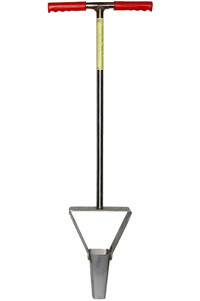
Features
- Makes a planting hole the right shape and depth so that trees grown in tubes can be easily planted
- Allows the positioning of the root mass close to the soil so that there are no air gaps. This means that little or no watering in is necessary, as the main aim of watering in is to eliminate air gaps in disturbed soil
- Reduces transplanting shock, ensuring good survival rates when using good quality tube stock, weed control and correct timing of planting
- Allows the use of pre-emergent herbicides as the actively growing roots are placed below the zone of herbicide which has been sprayed on to the soil surface for ongoing weed control
- Can be used in light and heavy soil types
- One person can plant at least 400 trees per day
- Has a hard wearing stainless steel head
- Can be used to apply fertiliser tablets to established plants, placing them deeply in the soil where the plants, rather than the weeds, will use the fertiliser
- Can be used for transplanting volunteer and direct seeded seedlings by coring out the plants, tubing them, taking them to their new location and replanting them. (The T7 model is the most suitable for this job as it takes a 75mm diameter core of soil around the plant. T7 tubes are available.)
- Used by farmers, contractors, land care groups, community and school groups, agriculture and forestry departments and councils
- Can be used in heavy compacted ground when ripped in the previous dry season
- Ideal for use when using herbicides or mulch for weed control
- Can be used without cultivation
Using the Hamilton Tree Planter
The Hamilton Tree Planter is pushed into the ground by holding the hand grips and putting weight onto the footsteps until the desired depth is reached. If the ground is very firm, jumping up onto the footsteps and thrusting your weight down will drive it into the ground. Once in the ground the round model is extracted while twisting, the square model is extracted while circling the handle in small circles (only small circles so the shape of the planting hole will not be destroyed). This stops the soil from falling back into the hole and stops adhesion to the outer surface. The soil in the head of the tree planter will be pushed out as the next planting hole is dug.
Planting trees grown in square plastic tubes
Turn the tube upside down with the trunk of the tree between your first two fingers, press the bottom of the tube so that the root mass is loosened, then taking the weight of the root mass on your two fingers with the tube still upside down, a quick downward motion should bring the tree out of the tube. The tree is then placed in the hole and pushed down to make sure it is contacting the bottom of the hole and then firmed by pressing the ground around the tree with your feet to bring the soil into close contact with the root mass. Any teasing out will damage roots. Only straggly roots should be removed prior to planting.
Planting trees grown in round veneers
Unroll the veneer, except for the last quarter, which is left in place to support the root mass, until planted. Lower the tree into the hole then remove the veneer, press very gently to make sure the root mass contacts the bottom of the hole, and firm with the feet. Any teasing out will damage roots. Only straggly roots should be removed prior to planting.
Planting trees grown in round plastic tubes
Zip down the side of the tube on two sides, and plant the same as for veneers.
Watering in will be needed if planting into recently cultivated soil (you will need a couple of buckets full if this is the case) or if the soil is starting to dry out (1-2 cups full). If the whole profile of the soil is wet through and there have been recent rains, there is no need for watering in as the soil will be brought into close contact with the root mass, eliminating any air gaps. But if you want to be on the safe side, one cup of water is all that is necessary.
The planting hole should be made one to two cm deeper than the root mass so that when firming around with the feet, the soil is brought level with the top of the root mass.
Your Hamilton Tree Planter is made robust enough to last many years of tree planting. But care should be taken when planting. It should not be used as a lever in the planting hole. If it does become blocked it can be cleared by pushing the blockage out from the narrow end. In very sticky, clayey soil placing the head in a bucket of water occasionally will help to stop blockages.


